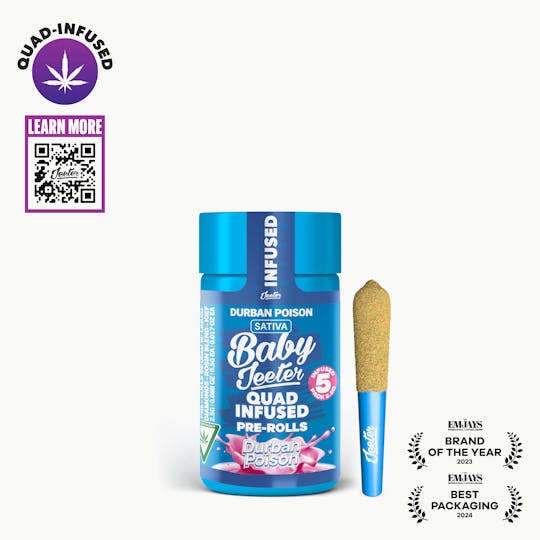
Baby Jeeter | Quad-Infused - Durban Poison
Durban Poison | Baby Jeeter | Sativa
5 x 0.5G Joints 2.5G Total
Quad-Infused | Premium Flower Infused with Liquid Diamonds, Rosin Blend & Kief
- Earthy
- Woody
- Spicy/Herbal
Your favorite Indoor 🔥 buds, rolled for you.
Jeeter, ranked the #1 Pre-Roll in the World, started its journey back in Miami, circa 2007. The company name was coined by a group of best friends who called their joints “jeeters” back in their high school days.
Present day, the Jeeter family is hard at work creating new top contenders in the industry. They’re continuously striving for bigger and better, and the team stays innovative in their product development and community engagements.
Which Jeeter product will be your new favorite?
Durban Poison has deep roots in the Sativa landrace gene pool. The strain’s historic phenotypes were first noticed in the late 1970s by one of America’s first International strain hunters, Ed Rosenthal. According to cultivation legend, Rosenthal was in South Africa in search of new genetics and ran across a fast flowering strain in the port city of Durban. After arriving home in the U.S., Rosenthal conducted his own selective breeding process on his recently imported seeds, then begin sharing. Rosenthal gave Mel Frank some of his new South African seeds, and the rest was cannabis history.
Frank, who wrote the “Marijuana Grower’s Guide Deluxe" in 1978, modified the gene pool to increase resin content and decrease the flowering time. In search of a short-season varietal that could hit full maturation on the U.S. East Coast, Frank’s crossbreeding efforts resulted in two distinct phenotypes, the “A” line and “B” line. The plant from Frank’s “A” line became today’s Durban Poison, while the “B” line was handed off to Amsterdam breeder David Watson, also known as “Sam the Skunkman.”
Durban Poison has a dense, compact bud structure that’s typical of landrace Indica varieties, but the flowers’ elongated and conical shape is more characteristic of a Sativa.